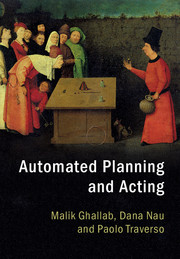Book contents
- Frontmatter
- Dedication
- Contents
- List of Algorithms
- Table of Notation
- Foreword
- Preface
- 1 Introduction
- 2 Deliberation with Deterministic Models
- 3 Deliberation with Refinement Methods
- 4 Deliberation with Temporal Models
- 5 Deliberation with Nondeterministic Models
- 6 Deliberation with Probabilistic Models
- 7 Other Deliberation Functions
- 8 Concluding Remarks
- Appendix A Search Algorithms
- Appendix B Strongly Connected Components of a Graph
- Bibliography
- Index
Preface
Published online by Cambridge University Press: 05 August 2016
- Frontmatter
- Dedication
- Contents
- List of Algorithms
- Table of Notation
- Foreword
- Preface
- 1 Introduction
- 2 Deliberation with Deterministic Models
- 3 Deliberation with Refinement Methods
- 4 Deliberation with Temporal Models
- 5 Deliberation with Nondeterministic Models
- 6 Deliberation with Probabilistic Models
- 7 Other Deliberation Functions
- 8 Concluding Remarks
- Appendix A Search Algorithms
- Appendix B Strongly Connected Components of a Graph
- Bibliography
- Index
Summary
This book is about methods and techniques that a computational agent can use for deliberative planning and acting, that is, for deciding both which actions to perform and how to perform them, to achieve
some objective. The study of deliberation has several scientific and engineering motivations.
Understanding deliberation is an objective for most cognitive sciences. In artificial intelligence research, this is done by modeling deliberation through computational approaches both to enable it and to allow it to be explained. Furthermore, the investigated capabilities are better understood by mapping concepts and theories into designed systems and experiments to test empirically,measure,and qualify the proposed models.
The engineering motivation for studying deliberation is to build systems that exhibit deliberation capabilities and develop technologies that address socially useful needs.A technological system needs deliberation capabilities if it must autonomously perform a set of tasks that are too diverse – ormust be done in environments that are too diverse – to engineer those tasks into innate behaviors. Autonomy and diversity of tasks and environments is a critical feature in many applications, including robotics (e.g., service and personal robots; rescue and exploration robots; autonomous space stations, satellites, or vehicles), complex simulation systems (e.g., tutoring, training or entertainment), or complex infrastructure management (e.g., industrial or energy plants, transportation networks, urban facilities).
MOTIVATION AND COVERAGE
The coverage of this book derives from the view we advocated for in our previous work [231], which we now briefly summarize.
Automated planning is a rich technical field, which benefits from the work of an active and growing research community. Some areas in this field are extensively explored and correspond to a number of already mature techniques. However, there are other areas in which further investigation is critically needed if automated planning is to have a wider impact on a broader set of applications. One of the most important such areas, in our view is the integration of planning and acting.This book covers several different kinds of models and approaches – deterministic, hierarchical, temporal,nondeterministic and probabilistic – and for each of them, we discuss not only the techniques themselves but also how to use them in the integration of planning and acting.
- Type
- Chapter
- Information
- Automated Planning and Acting , pp. xv - xviiiPublisher: Cambridge University PressPrint publication year: 2016

